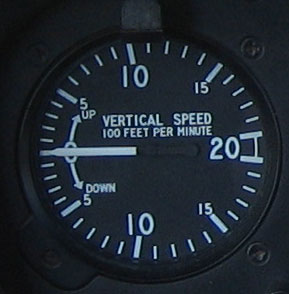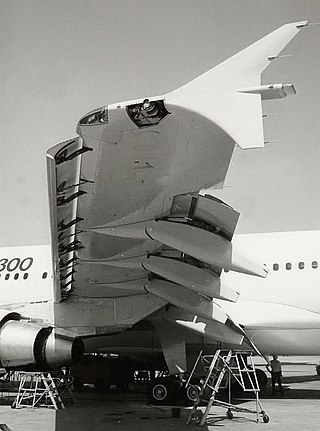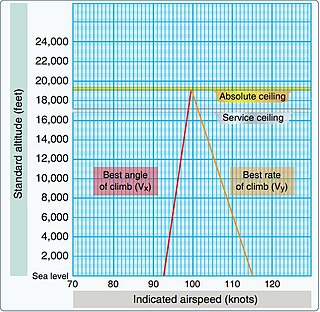For fixed-wing aircraft, ground effect is the reduced aerodynamic drag that an aircraft's wings generate when they are close to a fixed surface. During takeoff, ground effect can cause the aircraft to "float" while below the recommended climb speed. The pilot can then fly just above the runway while the aircraft accelerates in ground effect until a safe climb speed is reached.

Flight instruments are the instruments in the cockpit of an aircraft that provide the pilot with data about the flight situation of that aircraft, such as altitude, airspeed, vertical speed, heading and much more other crucial information in flight. They improve safety by allowing the pilot to fly the aircraft in level flight, and make turns, without a reference outside the aircraft such as the horizon. Visual flight rules (VFR) require an airspeed indicator, an altimeter, and a compass or other suitable magnetic direction indicator. Instrument flight rules (IFR) additionally require a gyroscopic pitch-bank, direction and rate of turn indicator, plus a slip-skid indicator, adjustable altimeter, and a clock. Flight into instrument meteorological conditions (IMC) require radio navigation instruments for precise takeoffs and landings.

In fluid dynamics, a stall is a reduction in the lift coefficient generated by a foil as angle of attack exceeds its critical value. The critical angle of attack is typically about 15°, but it may vary significantly depending on the fluid, foil – including its shape, size, and finish – and Reynolds number.

The Lockheed F-104 Starfighter is an American single-engine, supersonic interceptor which was extensively deployed as a fighter-bomber during the Cold War. Created as a day fighter by Lockheed as one of the "Century Series" of fighter aircraft for the United States Air Force (USAF), it was developed into an all-weather multirole aircraft in the early 1960s and produced by several other nations, seeing widespread service outside the United States.

In aviation, a variometer – also known as a rate of climb and descent indicator (RCDI), rate-of-climb indicator, vertical speed indicator (VSI), or vertical velocity indicator (VVI) – is one of the flight instruments in an aircraft used to inform the pilot of the rate of descent or climb. It can be calibrated in metres per second, feet per minute or knots, depending on country and type of aircraft. It is typically connected to the aircraft's external static pressure source.

Landing is the last part of a flight, where a flying animal, aircraft, or spacecraft returns to the ground. When the flying object returns to water, the process is called alighting, although it is commonly called "landing", "touchdown"a or "splashdown" as well. A normal aircraft flight would include several parts of flight including taxi, takeoff, climb, cruise, descent and landing.

In aerodynamics, wing loading is the total weight of an aircraft or flying animal divided by the area of its wing. The stalling speed, takeoff speed and landing speed of an aircraft are partly determined by its wing loading.

In flight dynamics a spin is a special category of stall resulting in autorotation about the aircraft's longitudinal axis and a shallow, rotating, downward path approximately centred on a vertical axis. Spins can be entered intentionally or unintentionally, from any flight attitude if the aircraft has sufficient yaw while at the stall point. In a normal spin, the wing on the inside of the turn stalls while the outside wing remains flying. It is possible for both wings to stall, but the angle of attack of each wing, and consequently its lift and drag, are different.

Aircraft flight control surfaces are aerodynamic devices allowing a pilot to adjust and control the aircraft's flight attitude.
The CarterCopter is an experimental compound autogyro developed by Carter Aviation Technologies in the United States to demonstrate slowed rotor technology. On 17 June 2005, the CarterCopter became the first rotorcraft to achieve mu-1 (μ=1), an equal ratio of airspeed to rotor tip speed, but crashed on the next flight and has been inoperable since. It is being replaced by the Carter Personal Air Vehicle.

The Northrop X-4 Bantam is a prototype small twinjet aircraft manufactured by Northrop Corporation in 1948. It had no horizontal tail surfaces, depending instead on combined elevator and aileron control surfaces for control in pitch and roll attitudes, almost exactly in the manner of the similar-format, rocket-powered Messerschmitt Me 163 of Nazi Germany's Luftwaffe. Some aerodynamicists had proposed that eliminating the horizontal tail would also do away with stability problems at fast speeds resulting from the interaction of supersonic shock waves from the wings and the horizontal stabilizers. The idea had merit, but the flight control systems of that time prevented the X-4 from achieving any success.

The Lockheed/Boeing/General Dynamics YF-22 is an American single-seat, twin-engine, stealth fighter technology demonstrator prototype designed for the United States Air Force (USAF). The design team, with Lockheed as the prime contractor, was a finalist in the USAF's Advanced Tactical Fighter (ATF) competition, and two prototypes were built for the demonstration/validation phase. The YF-22 team won the contest against the YF-23 team for full-scale development and the design was developed into the Lockheed Martin F-22. The YF-22 has a similar aerodynamic layout and configuration as the F-22, but with notable differences in the overall shaping such as the position and design of the cockpit, tail fins and wings, and in internal structural layout.

A flap is a high-lift device used to reduce the stalling speed of an aircraft wing at a given weight. Flaps are usually mounted on the wing trailing edges of a fixed-wing aircraft. Flaps are used to reduce the take-off distance and the landing distance. Flaps also cause an increase in drag so they are retracted when not needed.
In aviation, a phugoid or fugoid is an aircraft motion in which the vehicle pitches up and climbs, and then pitches down and descends, accompanied by speeding up and slowing down as it goes "downhill" and "uphill". This is one of the basic flight dynamics modes of an aircraft.

In aeronautics, the rate of climb (RoC) is an aircraft's vertical speed, that is the positive or negative rate of altitude change with respect to time. In most ICAO member countries, even in otherwise metric countries, this is usually expressed in feet per minute (ft/min); elsewhere, it is commonly expressed in metres per second (m/s). The RoC in an aircraft is indicated with a vertical speed indicator (VSI) or instantaneous vertical speed indicator (IVSI).

A pitot–static system is a system of pressure-sensitive instruments that is most often used in aviation to determine an aircraft's airspeed, Mach number, altitude, and altitude trend. A pitot–static system generally consists of a pitot tube, a static port, and the pitot–static instruments. Other instruments that might be connected are air data computers, flight data recorders, altitude encoders, cabin pressurization controllers, and various airspeed switches. Errors in pitot–static system readings can be extremely dangerous as the information obtained from the pitot static system, such as altitude, is potentially safety-critical. Several commercial airline disasters have been traced to a failure of the pitot–static system.

The Ling-Temco-Vought (LTV) XC-142 is a tiltwing experimental aircraft designed to investigate the operational suitability of vertical/short takeoff and landing (V/STOL) transports. An XC-142A first flew conventionally on 29 September 1964, and completed its first transitional flight on 11 January 1965 by taking off vertically, changing to forward flight, and finally landing vertically. Its service sponsors pulled out of the program one by one, and it eventually ended due to a lack of interest after demonstrating its capabilities successfully.

The Helios Prototype was the fourth and final aircraft developed as part of an evolutionary series of solar- and fuel-cell-system-powered unmanned aerial vehicles. AeroVironment, Inc. developed the vehicles under NASA's Environmental Research Aircraft and Sensor Technology (ERAST) program. They were built to develop the technologies that would allow long-term, high-altitude aircraft to serve as atmospheric satellites, to perform atmospheric research tasks as well as serve as communications platforms. It was developed from the NASA Pathfinder and NASA Centurion aircraft.
Throughout a normal flight, a pilot controls an aircraft through the use of flight controls including maintaining straight and level flight, as well as turns, climbing, and descending. Some controls, such as a "yoke" or "stick" move and adjust the control surfaces which affects the aircraft's attitude in the three axes of pitch, roll, and yaw. Other controls include those for adjusting wing characteristics and those that control the power or thrust of the propulsion systems. The loss of primary control systems in any phase of flight is an emergency. Aircraft are not designed to be flown under such circumstances; however, some pilots faced with such an emergency have had limited success flying and landing aircraft with disabled controls.

Aeroflot Flight 1912 was a scheduled domestic Aeroflot passenger flight on the Odessa-Kiev (Kyiv)-Chelyabinsk-Novosibirsk-Irkutsk-Khabarovsk-Vladivostok route that crashed on 25 July 1971, making a hard landing at Irkutsk Airport. It touched down 150 metres (490 ft) short of the runway, breaking the left wing and catching fire. Of the 126 people on board the aircraft, 29 survived.
















